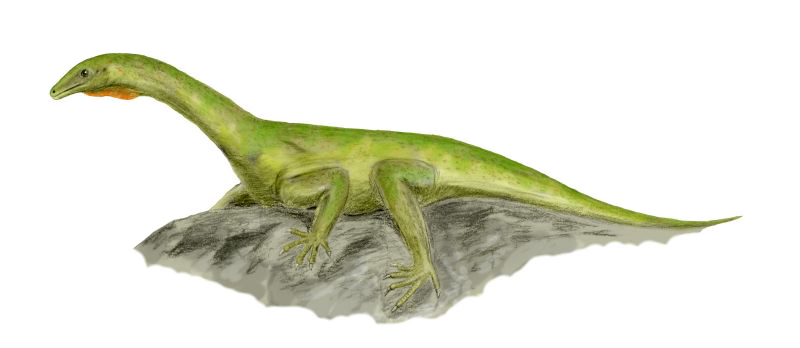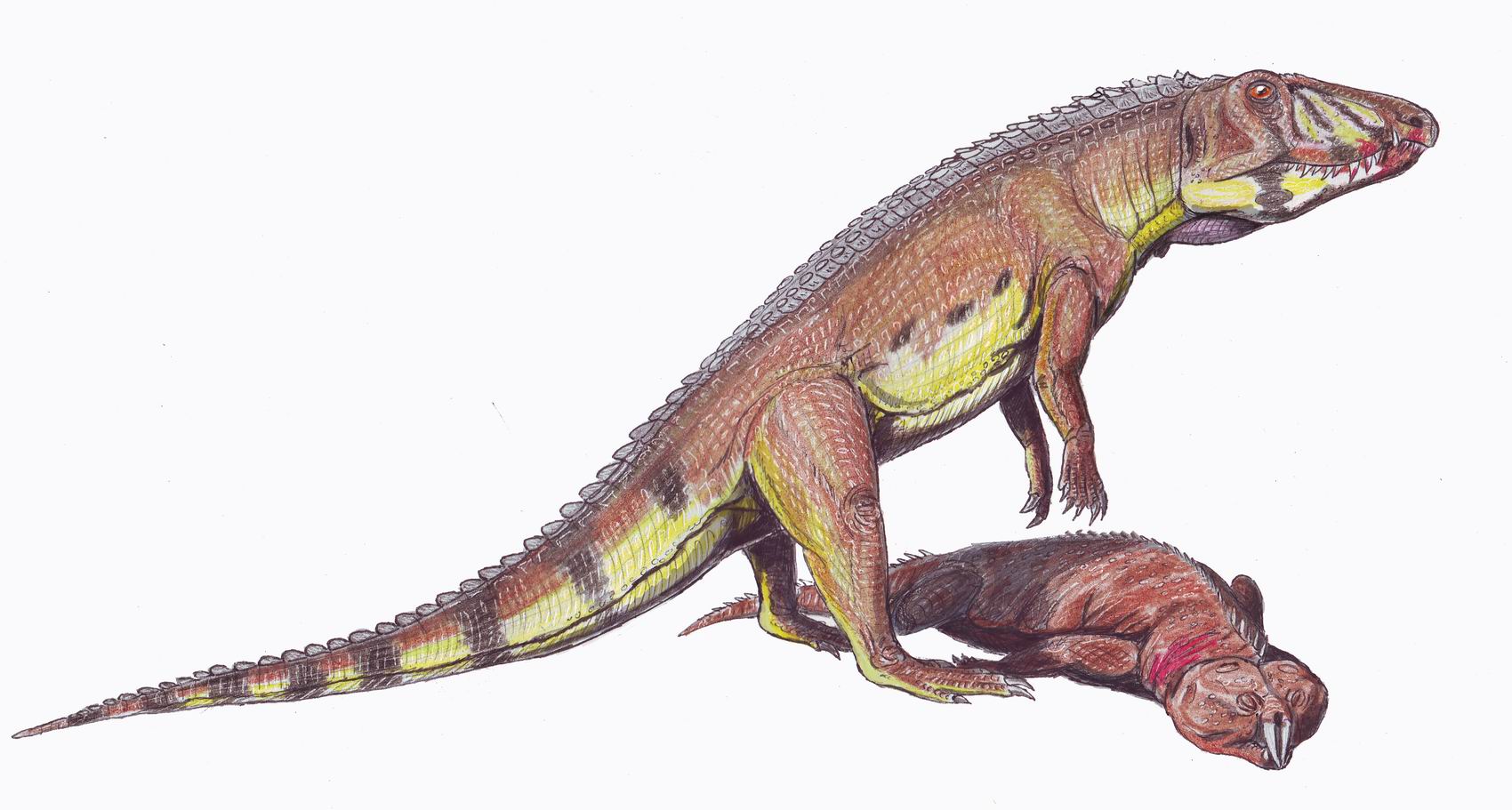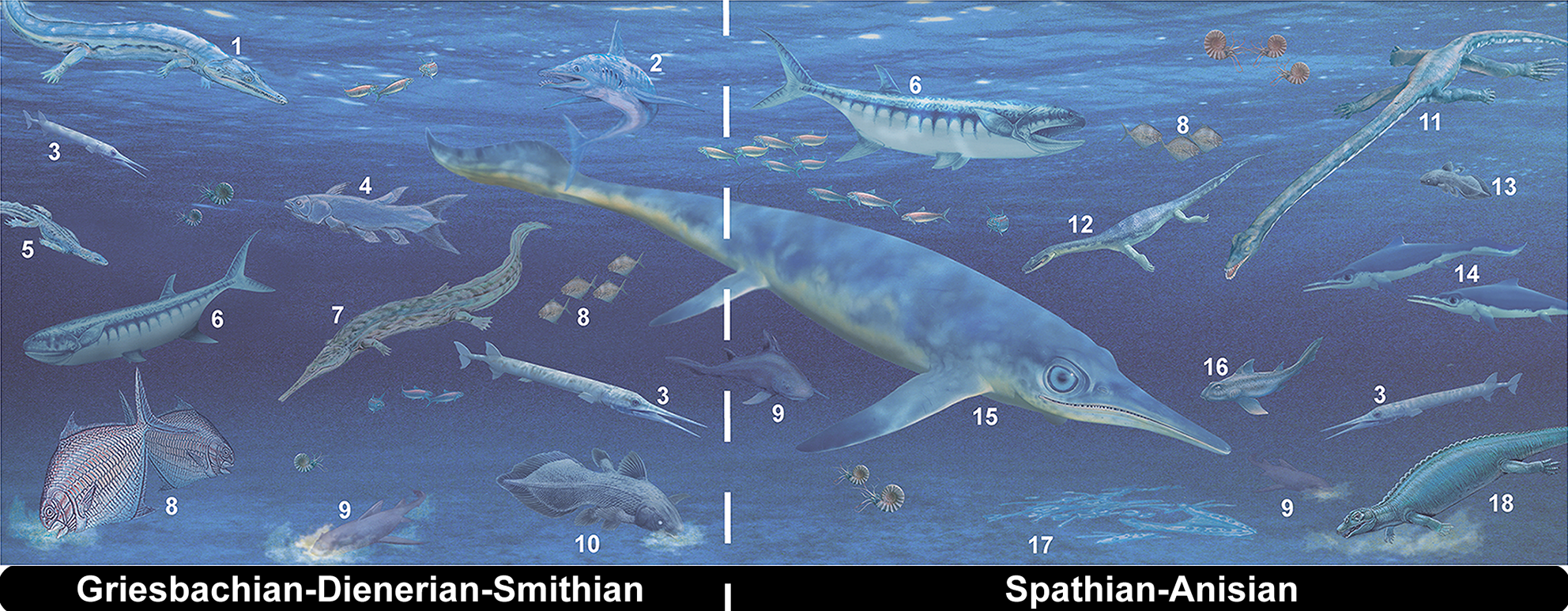|
Boreopricea
''Boreopricea'' is an extinct genus of archosauromorph reptile from the Early Triassic of arctic Russia. It is known from a fairly complete skeleton discovered in a borehole on Kolguyev Island, though damage to the specimen and loss of certain bones has complicated study of the genus. ''Boreopricea'' shared many similarities with various other archosauromorphs, making its classification controversial. Various studies have considered it a close relative of '' Prolacerta'', tanystropheids, both, or neither. ''Boreopricea'' is unique among early archosauromorphs due to possessing contact between the jugal and squamosal bones at the rear half of the skull. History ''Boreopricea funerea'' was named and described by Soviet paleontologist L. P. Tatarinov in 1978. It was primarily based on a fairly complete skull and skeleton collected in 1972 from a borehole at Kolguyev Island in the Arctic Ocean. This holotype specimen, PIN 3708/1, included bones from most of the body, apart fro ... [...More Info...] [...Related Items...] OR: [Wikipedia] [Google] [Baidu] |
Archosauromorph
Archosauromorpha (Greek for "ruling lizard forms") is a clade of diapsid reptiles containing all reptiles more closely related to archosaurs (such as crocodilians and dinosaurs, including birds) than to lepidosaurs (such as tuataras, lizards, and snakes). Archosauromorphs first appeared during the late Middle Permian or Late Permian, though they became much more common and diverse during the Triassic period. Although Archosauromorpha was first named in 1946, its membership did not become well-established until the 1980s. Currently Archosauromorpha encompasses four main groups of reptiles: the stocky, herbivorous allokotosaurs and rhynchosaurs, the hugely diverse Archosauriformes, and a polyphyletic grouping of various long-necked reptiles including '' Protorosaurus'', tanystropheids, and '' Prolacerta''. Other groups including pantestudines (turtles and their extinct relatives) and the semiaquatic choristoderes have also been placed in Archosauromorpha by some authors. Ar ... [...More Info...] [...Related Items...] OR: [Wikipedia] [Google] [Baidu] |
Early Triassic
The Early Triassic is the first of three epochs of the Triassic Period of the geologic timescale. It spans the time between 251.9 Ma and Ma (million years ago). Rocks from this epoch are collectively known as the Lower Triassic Series, which is a unit in chronostratigraphy. The Early Triassic is the oldest epoch of the Mesozoic Era. It is preceded by the Lopingian Epoch (late Permian, Paleozoic Era) and followed by the Middle Triassic Epoch. The Early Triassic is divided into the Induan and Olenekian ages. The Induan is subdivided into the Griesbachian and Dienerian subages and the Olenekian is subdivided into the Smithian and Spathian subages. The Lower Triassic series is coeval with the Scythian Stage, which is today not included in the official timescales but can be found in older literature. In Europe, most of the Lower Triassic is composed of Buntsandstein, a lithostratigraphic unit of continental red beds. The Early Triassic and partly also the Middle Trias ... [...More Info...] [...Related Items...] OR: [Wikipedia] [Google] [Baidu] |
Holotype
A holotype (Latin: ''holotypus'') is a single physical example (or illustration) of an organism used when the species (or lower-ranked taxon) was formally described. It is either the single such physical example (or illustration) or one of several examples, but explicitly designated as the holotype. Under the International Code of Zoological Nomenclature (ICZN), a holotype is one of several kinds of name-bearing types. In the International Code of Nomenclature for algae, fungi, and plants (ICN) and ICZN, the definitions of types are similar in intent but not identical in terminology or underlying concept. For example, the holotype for the butterfly '' Plebejus idas longinus'' is a preserved specimen of that subspecies, held by the Museum of Comparative Zoology at Harvard University. In botany and mycology, an isotype is a duplicate of the holotype, generally pieces from the same individual plant or samples from the same genetic individual. A holotype is not necessarily "ty ... [...More Info...] [...Related Items...] OR: [Wikipedia] [Google] [Baidu] |
Diapsid
Diapsids ("two arches") are a clade of sauropsids, distinguished from more primitive eureptiles by the presence of two holes, known as temporal fenestrae, in each side of their skulls. The earliest traditionally identified diapsids, the araeoscelidians, appeared about three hundred million years ago during the late Carboniferous period. All diapsids other than the most primitive ones in the clade Araeoscelidia are often placed into the clade Neodiapsida. The diapsids are extremely diverse, and include birds and all modern reptile groups, including turtles, which were historically thought to lie outside the group. All modern reptiles and birds are placed within the neodiapsid subclade Sauria. Although some diapsids have lost either one hole (lizards), or both holes (snakes and turtles), or have a heavily restructured skull (modern birds), they are still classified as diapsids based on their ancestry. At least 17,084 species of diapsid animals are extant: 9,159 birds, and 7,925 s ... [...More Info...] [...Related Items...] OR: [Wikipedia] [Google] [Baidu] |
Orbit (anatomy)
In anatomy Anatomy () is the branch of morphology concerned with the study of the internal structure of organisms and their parts. Anatomy is a branch of natural science that deals with the structural organization of living things. It is an old scien ..., the orbit is the Body cavity, cavity or socket/hole of the skull in which the eye and Accessory visual structures, its appendages are situated. "Orbit" can refer to the bony socket, or it can also be used to imply the contents. In the adult human, the volume of the orbit is about , of which the eye occupies . The orbital contents comprise the eye, the Orbital fascia, orbital and retrobulbar fascia, extraocular muscles, cranial nerves optic nerve, II, oculomotor nerve, III, trochlear nerve, IV, trigeminal nerve, V, and abducens nerve, VI, blood vessels, fat, the lacrimal gland with its Lacrimal sac, sac and nasolacrimal duct, duct, the eyelids, Medial palpebral ligament, medial and Lateral palpebral raphe, lateral palpebr ... [...More Info...] [...Related Items...] OR: [Wikipedia] [Google] [Baidu] |
Martin Ezcurra
Martin may refer to: Places Antarctica * Martin Peninsula, Marie Byrd Land * Port Martin, Adelie Land * Point Martin, South Orkney Islands Europe * Martin, Croatia, a village * Martin, Slovakia, a city * Martín del Río, Aragón, Spain * Martín River, a tributary of the Ebro river in Spain * Martin (Val Poschiavo), Switzerland England * Martin, Hampshire * Martin, Kent * Martin, East Lindsey, Lincolnshire, a hamlet and former parish * Martin, North Kesteven, Lincolnshire, a village and parish * Martin Hussingtree, Worcestershire * Martin Mere, a lake in Lancashire ** WWT Martin Mere, a wetland nature reserve that includes the lake and surrounding areas North America Canada * Rural Municipality of Martin No. 122, Saskatchewan, Canada * Martin Islands, Nunavut, Canada United States * Martin, Florida * Martin, Georgia * Martin, Indiana * Martin, Kentucky * Martin, Louisiana * Martin, Michigan * Martin, Nebraska * Martin, North Dakota * Martin, Ohio * Martin, Sou ... [...More Info...] [...Related Items...] OR: [Wikipedia] [Google] [Baidu] |
Palate
The palate () is the roof of the mouth in humans and other mammals. It separates the oral cavity from the nasal cavity. A similar structure is found in crocodilians, but in most other tetrapods, the oral and nasal cavities are not truly separated. The palate is divided into two parts, the anterior, bony hard palate and the posterior, fleshy soft palate (or velum). Structure Innervation The maxillary nerve branch of the trigeminal nerve supplies sensory innervation to the palate. Development The hard palate forms before birth. Variation If the fusion is incomplete, a cleft palate results. Function in humans When functioning in conjunction with other parts of the mouth, the palate produces certain sounds, particularly velar, palatal, palatalized, postalveolar, alveolopalatal, and uvular consonants. History Etymology The English synonyms palate and palatum, and also the related adjective palatine (as in palatine bone), are all from the Latin ''palatum' ... [...More Info...] [...Related Items...] OR: [Wikipedia] [Google] [Baidu] |
Jackie Allen (paleontologist)
Jackie Allen may refer to: * Jackie Allen (American football) (born 1947), cornerback in American football * Jackie Allen (musician) (born 1959), jazz vocalist and composer {{hndis, Allen, Jackie ... [...More Info...] [...Related Items...] OR: [Wikipedia] [Google] [Baidu] |
Michael Benton
Michael James Benton (born 8 April 1956) is a British palaeontologist, and professor of vertebrate paleontology, vertebrate palaeontology in the School of Earth Sciences at the University of Bristol. His published work has mostly concentrated on the evolution of Triassic reptiles but he has also worked on extinction events and faunal changes in the fossil record. Education Benton was educated at Robert Gordon's College, the University of Aberdeen and Newcastle University where he was awarded a PhD in 1981. Research and career Benton's research investigates palaeobiology, palaeontology, and macroevolution. His research interests include: diversification of life, quality of the fossil record, shapes of phylogenies, age-clade congruence, mass extinctions, Triassic ecosystem evolution, basal diapsid phylogeny, basal archosaurs, and the origin of the dinosaurs. He has made fundamental contributions to understanding the history of life, particularly concerning how biodiversity chang ... [...More Info...] [...Related Items...] OR: [Wikipedia] [Google] [Baidu] |
University Of Bristol
The University of Bristol is a public university, public research university in Bristol, England. It received its royal charter in 1909, although it can trace its roots to a Merchant Venturers' school founded in 1595 and University College, Bristol, which had been in existence since 1876. Bristol Medical School, founded in 1833, was merged with the University College in 1893, and later became the university's school of medicine. The university is organised into #Academic structure, six academic faculties composed of multiple schools and departments running over 200 undergraduate courses, largely in the Tyndalls Park area of the city. It had a total income of £1.06 billion in 2023–24, of which £294.1 million was from research grants and contracts, with an expenditure of £768.7 million. It is the largest independent employer in Bristol. Current academics include 23 fellows of the Academy of Medical Sciences, 13 fellows of the British Academy, 43 fellows of the Academy of Soc ... [...More Info...] [...Related Items...] OR: [Wikipedia] [Google] [Baidu] |
Olenekian
In the geologic timescale, the Olenekian is an age (geology), age in the Early Triassic epoch (geology), epoch; in chronostratigraphy, it is a stage (stratigraphy), stage in the Lower Triassic series (stratigraphy), series. It spans the time between annum, Ma and Ma (million years ago). The Olenekian is sometimes divided into the Smithian and the Spathian subages or substages. The Olenekian follows the Induan and is followed by the Anisian (Middle Triassic). The Olenekian saw the deposition of a large part of the Buntsandstein in Europe. The Olenekian is roughly coeval with the regional Yongningzhenian Stage used in China. Stratigraphic definitions The Olenekian Stage was introduced into scientific literature by Russian stratigraphers in 1956. The stage is named after Olenëk in Siberia. Before the subdivision in Olenekian and Induan became established, both stages formed the Scythian Stage, which has since disappeared from the official timescale. The base of the Olenekian is ... [...More Info...] [...Related Items...] OR: [Wikipedia] [Google] [Baidu] |
Biochronology
In paleontology, biochronology is the correlation in time of biological events using fossils. In its strict sense, it refers to the use of assemblages of fossils that are not tied to stratigraphic sections (in contrast to biostratigraphy, where they are). Collections of land mammal ages have been defined for every continent except Antarctica, and most are correlated with each other indirectly through known evolutionary lineages. A combination of argon–argon dating and magnetostratigraphy, magnetic stratigraphy allows a direct temporal comparison of terrestrial events with climate variability, climate variations and Extinction event, mass extinctions. Comparison with biostratigraphy In sedimentary rocks, fossils are the only widely applicable tool for time correlation. Evolution leaves a record of progressive change, sequential and nonrepeating. A rock unit has a characteristic Faunal assemblage, assemblage of fossils, independent of its lithology. Thus, the fossils can be use ... [...More Info...] [...Related Items...] OR: [Wikipedia] [Google] [Baidu] |





